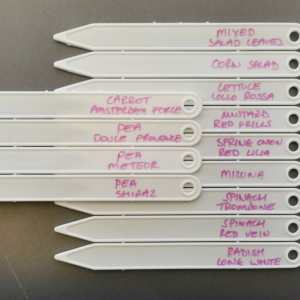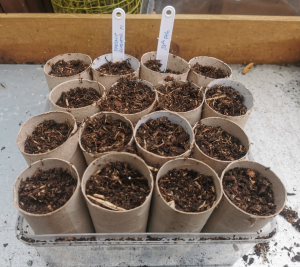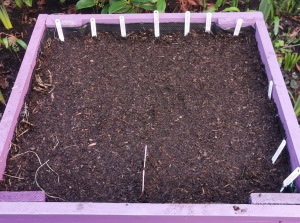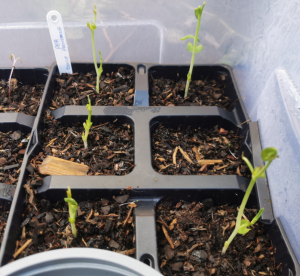
Introduction:
March is the start of the growing your own frenzy! I get very excited in March and try to start everything, but this year I will pace myself.
Read the January guide here and the February guide here.
If you are new to growing your own food and want to have a go, why not start this year?
Email us for a free PDF guide to help you! Laura will also help via social media or email – laura.hamilton@tcv.org.uk
What You’ll Need:
- Seeds!
- Plant labels – I use lollipop craft sticks from Poundland, but you can also cut up empty clean milk bottles into strips and use that
- A marker pen to write on the labels
- Peat free compost
- Plant pots
- A protective cover – greenhouse, polytunnel, plastic bags over pots, or folding plastic food trays (eat the pastry first!). You could also use a stackable clear plastic box
- A drip tray if indoors – plate, bowl, drip tray, plastic fruit punnet (without holes), plastic bags also work
Choose Your Location:
A south facing room or window will be the hottest place in the house and get most direct sunlight, but any space will do. I have a mini plastic greenhouse in the garden which is north facing, but the greenhouse gets most of the sunlight each day. I also fully utilise every windowsill available!
For direct sowing, you can try lots of different things. You can grow food in hanging baskets, borders, raised beds, pots, or old tyres. Raised beds can be timber frames, or just edged with bricks, large pebbles, or breeze blocks.
Seeds to Sow in March:
March is the start of direct sowing! You might need to wait until the middle or end of the month if the ground is cold or still frozen. You could put down a thick layer of cardboard to help warm the soil at the start of the month.
This month, seeds you can sow indoors/under cover include:
- Pea – meteor, douce provence, early onward, and twinkle.
- Sprout – any variety
- Broad bean – aquadulce claudia
- French bean – borlotti and cobra
- Cabbage – kalibos, caraflex F1, and attraction F1
- Salad – lettuce, and mustard (red frills)
You could also catch up in March if you haven’t already started cauliflower, tomatoes, or aubergine, and herbs including chives, basil and parsley.
Seeds to sow outdoors:
- Broad bean – aquadulce Claudia
- Spinach – trombone F1
- Chard
- Corn salad (lambs lettuce)
- Parsnip – student (wait until the end of the month!)
- Beetroot
- Radish
- Leek – giant winter
- Pea – twinkle
- Mizuna (salad leaf)
Flowers:
- Calendula (edible)
Herbs:
- Coriander
- Borage – this takes over so only plant one or two seeds.
If the ground is frozen, you will need to delay the outdoor direct seed sowing until the ground has thawed. You could use cardboard or thick black plastic to help warm the soil. Parsnips will not germinate in cold soil, so wait until the end of March to sow these, or start them in toilet roll tubes indoors.
Planting Out in March:
Towards the end of the month, I will be planting out my cauliflower, calabrese, and sprouts. I will also pot up my aubergine and tomatoes into bigger pots.
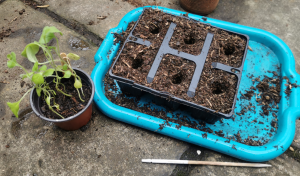
Mid-March, I have potted up my aubergine seedlings into a six pot tray. This will give each plant more room to grow and develop strong roots.
How to Do It:
Different food crops have different requirements – some need deep earth for the roots to grow (parsnip) and others can be grown in shallow trays on a windowsill (spinach and corn salad).
Start these seeds in module trays to give them a head start:
- Cabbage
- Pea
- Sprout
- Chard
- Leek
- French beans
Put some peat free compost in the trays and place seeds on top of the compost. Gently press the seed in, cover them over, and water. Remember to label the trays! Use the size of the modules to decide how many seeds go in each – if the module is only 3cm wide, only put one or two seeds in.
Peas, bean, and chard should only have two or three seeds per module.
Cabbage, sprout, and leek can have more – up to ten per module.
I am going to start parsnip indoors in toilet roll tubes, one seed per tube. When the plants are around 6cm tall, I will plant the entire toilet roll tubes.
Sow these seeds directly where you want them to grow:
- Broad bean – aquadulce Claudia – sow these 15cm apart. Do not sow them by onion, leek, garlic, or chives.
- Spinach – trombone F1 – sow in rows, you can do this in between other crops such as beans or peas.
- Chard – you can start this in modules or direct sow. Why not try both? Chard can grow 60cm tall so make sure you give each seed enough room to reach its full potential! Space them at least 30cm apart in each direction.
- Corn salad (lambs lettuce) – sow in rows, you can do this in between other crops such as beans or peas.
- Parsnip – student – parsnip need room to grow downwards and outwards. Plant seeds 10cm apart in all directions. You might need to mix some sand into the ground/pot/raised bed to make the earth soft for the roots to swell without forking or splitting.
- Beetroot – sow these in rows, leaving 10cm between each seed.
- Radish – sow these in rows or blocks, leaving 5cm between seed.
- Leek – giant winter – do not plant these near peas or beans. Sow them 10cm apart. The seeds are tiny and leeks take a long time to grow! If you sow them now, they will be ready to harvest next spring.
- Pea – twinkle – sow 15cm apart. Cover with netting to stop the birds eating them as they start growing.
Harvesting Food in March:
Seeds started in 2020 should be ready to harvest in early 2021, or start them in 2021 to harvest in 2022!
- Leek – giant winter
- Spring onion – white lisbon winter hardy
- Lettuce – winter density
- Swede
Seeds Sown in February:
The seeds you sowed in February should be growing! I only sowed mine in the middle of February so not all of the seeds have germinated. If you started yours and put them in boxes, remember to take the lids off to allow the air to ventilate.
Potting Up Last Months Plants:
The aubergine that I sowed in January are now ready for pricking out and potting up.
Remember to tag us and share pictures with us on social media – find us on:
And if you want help and advice, why not join our Grow Well, Eat Well group on Facebook? –
Don’t forget to claim your free guide via email, and happy growing!
